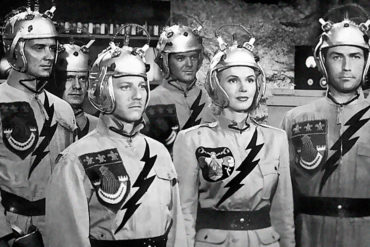When my friend’s husband commissioned me to create a painting based on a famous scene of Rabbi Abraham Joshua Heschel and Reverend Martin Luther King Jr. protesting together in the 1960s, I was thrilled.
The scenes of them marching conveyed to me an ideal that I saw religious, ethnic, and national groups around the world still struggling to reach; standing up for people other than their own kind, because of a shared sense of justice and humanity in the image of Gd. With the severe social justice issues going on in American society today, and the dangers we face due to them, I also wanted to create this piece as an opportunity to pour my feelings of hope and fear into it.
I was doubly thrilled because my husband, Elad, has been busy the last few months, devouring the late Dr. King’s speeches-now wholly accessible via YouTube. Sharing with me quotes and ideas for weeks now, Elad educated me excitedly, late at night or in the peaceful twilight of a Shabbos meal, about King’s approach and insights into the complexity of attaining real social and economic justice. As I set down to carve out the portrait, my hands gripping my beloved caran d’ache watercolor crayons, King’s words, storming across the decades since his death, pushed my fingers down into my tools, releasing his ideas through the pressure of my hands in the movements of creation.
“What does it profit a man to be able to eat at an integrated lunch counter,” King demanded in 1968, “if he doesn’t earn enough money to buy a hamburger and a cup of coffee?… This country has socialism for the rich, rugged individualism for the poor.
“Those who lived in the other America,” he continued, were plagued by “inadequate, substandard, and often dilapidated housing conditions,” by “substandard, inferior, quality-less schools,” by having to choose between unemployment and low-wage jobs that didn’t even pay enough to put food on the table.”
In his words, I heard King’s shift from racial to economic justice that so perturbed even his own usual supporters, to say the least for the rest of America. Nevertheless, he spoke his mind.
“What does it profit a man to be able to eat at an integrated lunch counter if he doesn’t earn enough money to buy a hamburger and a cup of coffee?”
As my hands flew from one face to the other, I pondered the different dynamics at play. In between spurts of laying down colors, light, and shadows, I used my phone to research Heschel and King’s relationship, and the complexity of the non-Jewish Blacks/Jewish alliance during the Civil Rights movement. How close were Heschel and King, really? How did Heschel end up being on the front lines of the March in Selma?
I was pleased to find out that Heschel and King did, indeed, deeply connect to and respect each other.
Meeting for the first time at a 1963 conference in Chicago on “Religion and Race” organized by the National Conference of Christians and Jews (NCCJ), King declared that, “The undergirding philosophy of segregation is diametrically opposed to the undergirding philosophy of our Judeo-Christian heritage, and all the dialectics of the logicians cannot make them lie down together.”
Heschel also gave a fiery address that night, lamenting that, “The exodus began, but is far from having been completed. In fact, it was easier for the children of Israel to cross the Red Sea than for a Negro to cross certain university campuses.”
Heschel’s speech prompted Cornel West to call it the strongest condemnation of racism by a white man since William Lloyd Garrison. “Racism is Satanism, unmitigated evil,” Heschel declared in the same oration. “You cannot worship God and at the same time look at man as if he were a horse.”
Heschel’s book The Prophets was lauded and quoted by King and other black, nonJewish social justice warriors. King specifically invited Heschel to join him on the Selma march in the front row,and a week before King was shot, he was invited by Heschel to speak at Heschel’s birthday party. The commitment and belief they had in each other was clear. As was the involvement of many Jews within the Civil Rights movement.
“In the 1960s, the critical decade of the voter-registration drives, as many as 90 percent of the civil rights lawyers in Mississippi were Jewish. Large numbers of them were recent graduates of Ivy League law schools. They worked around the clock analyzing welfare standards, the bail system, arrest procedures, justice-of-the-peace rulings. Racing from one Southern town to another, they obtained parade permits and issued complaints on jail beatings and intimidation.
Jews similarly made up at least 30 percent of the white volunteers who rode freedom buses to the South, registered blacks, and picketed segregated establishments. Among them were several dozen Reform rabbis who marched among the demonstrators in Selma and Birmingham. A number were arrested. Others were taken into custody for attempting to desegregate a swimming pool in St. Augustine, Florida. One of the demonstrating rabbis, Arthur Lelyveld, was severely beaten in Hattiesburg, Mississippi.”
Wow, yes, many reasons to be proud of Jews involved with racial justice in the 60’s. But the more I dug into things, sitting in the quiet of my studio space while the words of the internet swirled around me, jumping from article to article, the more complexity and strife I found, and the more the issue of economic justice which MLK was shouting about in 1968 become a clear issue that was not acknowledged enough by Jews or the rest of the country.
As the author, Mark Dollinger, of Black Power, Jewish Politics explained in Dismantling the Myths of the Black-Jewish Alliance, “with the passage of the Civil Rights Act, which ended legal segregation in America, the Jews celebrated and thought a great victory was won. But the blacks did not see it the same way. They knew there was still deep institutional systemic racism that had not been addressed.”
He continued:
“In the 1950s, the suburbs opened up to Jews before they opened up to blacks. So Jews moved into these brand-new homes but blacks could not do the same. Then, in the cities, as soon as the blacks moved into their neighborhood, the Jews took off — except that Jews still owned the apartment buildings. So when they fled to the suburbs they were profiting from blacks but refusing to live with them. The Jews were putting on this public face of being liberal, but in terms of the actual lives they were leading, it was anything but that.”
What a powerful point. The interplay of two minority groups that endured prejudice, but in different ways, created a complicated dance of experience in history. As Nylah Burton, herself a recipient to painful racial divides within the Jewish community explains,
“Despite enjoying legal equality, Jews were still kept outside the mainstream for much of American history. One consequence of their marginalization was that Jews were steered into certain career paths and barred from certain schools in the first half of the 20th century, and due to real estate restrictions, Jews and Black people often lived in the same neighborhoods. The paradoxical combination of white privilege and marginality meant that Jews often found themselves in intimate and unequal dynamics with their Black neighbors, which then reinforced stereotypical roles between Jews and Black people: landlord and tenant, shop owner and customer, lawyer and defendant, and so on.”
Martin Luther King Jr. himself even spoke about the devastating effect of negative personal, practical experience in A Testament of Hope: The Essential Writings and Speeches of Martin Luther King, Jr.:
“When we were working in Chicago, we had numerous rent strikes on the West Side, and it was unfortunately true that, in most instances, the persons we had to conduct these strikes against were Jewish landlords… We were living in a slum apartment owned by a Jew and a number of others, and we had to have a rent strike. We were paying $94 for four run-down, shabby rooms, and …. we discovered that whites … were paying only $78 a month. We were paying 20 percent tax. The Negro ends up paying a color tax and this has happened in instances where Negroes actually confronted Jews as the landlord or the storekeeper. The irrational statements that have been made are the result of these confrontations.”
In addition to these economic issues, however, there were other substantial issues from African-Americans in the social justice world that also contributed to schism between the Black-Jewish alliance. As Michael Fischbach explains in How the 1960s Civil Rights and Black Power Movements Split on Israel:
“In 1964, there was an internal struggle within the black civil rights movement between King and a new generation of more militant black youth. Eventually the influential black organization SNCC [Student Nonviolent Coordinating Committee], purged whites from the leadership — which in effect meant Jews. The black power activists and also the Nation of Islam saw the Jews as white, not as fellow travelers who also have suffered from oppression. The Jews, in their point of view, were firmly entrenched in the white establishment but didn’t own it.”
In addition, many Jews and Jewish institutions involved with civil rights were disillusioned by what they felt was lack of support during the struggle of the 1967 Israeli war, with the possibility of Israel on the brink of extinction looming. Fischback continues, describing how:
“The Black Power movement’s increasingly vocal support of the Palestinian national liberation movement starting in mid-1967 did not just engender public controversy among Jews and others who were accustomed to widespread American support for Israel. These pro-Palestinian sentiments also made traditional black civil rights leaders uneasy and put them on the defensive for a number of reasons. By the time of the 1967 war, mainstream black groups were already feeling marginalized by the Black Power movement. They struggled to maintain the initiative at a time when the “classic” civil rights struggle in the South was generally over and when Black Power advocates were confronting institutional racism in the North along more aggressive lines. While traditional civil rights groups worked within interracial coalitions to change the system, Black Power militants spoke openly of revolution against the system on their own without white allies.
“The [mainstream civil rights movement] suffered from the growing white—particularly, Jewish—backlash as the black freedom struggle moved to the North, replete with violent urban insurrections and sharp denunciations of everything from American capitalism and foreign policy to Israel and Zionism.”
Communities and alliances splintered in the late 60’s. We continue to feel the plates splintering beneath our feet.
Nowadays, the issues of poverty and economic justice that were King’s battle cry before his death continue to cause social upheaval. In The Neighborhood Is Mostly Black. The Home Buyers Are Mostly White, we see the problem clearly, as it describes how in one particular town, “In the aftermath of the housing bust, mortgage lending tightened, particularly for African-Americans and Hispanics. White buyers got a head start in places like South Park just as they were becoming newly desirable. By the time more lending returned for minorities, these neighborhoods were increasingly priced out of reach.”
The article also explains that:
“In the places where white households are moving, reinvestment is possible mainly because of the disinvestment that came before it. Many of these neighborhoods were once segregated by law and redlined by banks…Here, integration is not going very well. Pastor Jones expects that will be the story of the neighborhood: “You have a half-million-dollar home next to a home that’s maybe $20,000. I wish that could stay. I wish those families could get to know each other,” he said. “But because of economics, that can’t happen…White flight and white return are not opposite phenomena in American cities, generations apart. Here they are part of the same story.”
My mind, circulating on overdrive with information on these complex dances between different movements, tribes, and humanity, funneled its findings into the emerging image of Heschel and King protesting together at the Arlington National Cemetery on my canvas. As the pain of the past and the present welled up within me, I spilled the energy of it into the canvas. Between the acts of my mind, heart, and hands, their stoic yet celebratory image arose, and reminded me of many things.
It reminded me of the ability of Jews and different ethnic groups to look beyond their own circle of concern to stand up for the greater good of humanity, despite hardships or inconveniences.
But it also reminded me that we have not yet crossed the sea, that the fight for peace via economic justice is not close to being over. Beyond laws and rhetoric, if all people cannot enjoy a decent standard of living, if we cannot share our resources, and allow national upward mobility, how could true freedom or peace materialize throughout every layer of society? It’s the practical truth King tried it educate us on in 1968, and the echoes of his lamentations of our miscalculations still pound on our streets today.
We are more than our tribe. And our tribe is larger than we imagine. Perhaps that’s why people are afraid of joining with others, in fear of obliterating a sense of self and tribal identity.
Yet another question still looms from the late 60’s: when a schism arises from issues that are core to identity and belief, such as Zionism, and philosophically diametrically opposed people that would otherwise want to align themselves find themselves facing each other, where is the solution found?
And in a city like mine, Crown Heights, Brooklyn, where nonJewish blacks, mainly Caribbean, and mostly white Chassidic Jews live right next door to each other, yet endure both a spread of white nationalism among the Chassidic community, and a bout of antisemitic attacks from nonJewish blacks, usually youth, as well. The tremors of disunity can reach a cacophonous pitch.
It feels like the path to unity is both simple and utterly complicated, a mystery to still to unravel, of how to become better, together.
The Rabbi and the Reverend were filled with hope of reconciliation, as they roared from their mountaintops, as Heschel did in a 1964 speech, “The White Man on Trial”: “The tragedy of Pharaoh was the failure to realize that the exodus from slavery could have spelled redemption for both Israel and Egypt. Would that Pharaoh and the Egyptians had joined the Israelites in the desert and together stood at the foot of Sinai!”
This is the strife and the hope I found behind the linked arms of Heschel and King as I let loose on the canvas creating their image, connecting with their vision, feeling the warmth and power of their friendship and dreams, and resolving to somehow find my way to get up off my chair decades later, to join the rows of marchers behind them.





